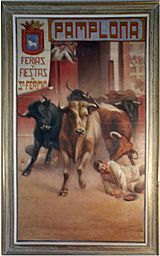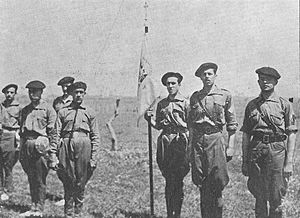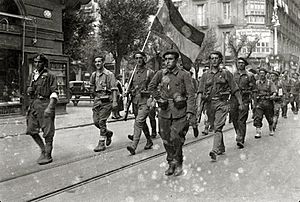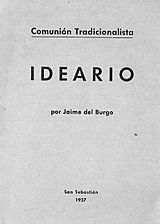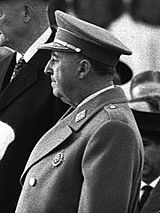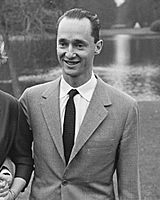Jaime del Burgo Torres facts for kids
Quick facts for kids
Jaime del Burgo Torres
|
|
|---|---|
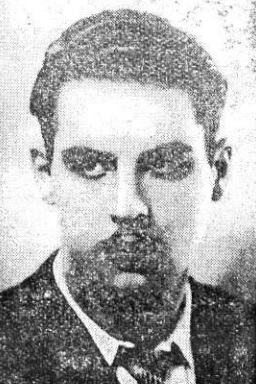 |
|
| Born |
Jaime del Burgo Torres
1912 Pamplona, Spain
|
| Died | 2005 (aged 92–93) Pamplona, Spain
|
| Nationality | Spanish |
| Occupation | public servant |
| Known for | Politician |
| Political party | Comunión Tradicionalista, FET |
Jaime del Burgo Torres (1912 – 2005) was an important Spanish official, writer, and a Carlist activist. He is best known as a historian. His writings focused on the region of Navarre and the Carlist Wars, which were a series of civil wars in Spain. As a public servant, he led Navarre's library system for many years. He also worked as a delegate for the Ministry of Information and as a tourism official. As a Carlist, he was a key organizer of the Navarrese Requeté (a Carlist militia) in the 1930s. He also supported the Carloctavista group during the early years of Francoism, which was the dictatorship of Francisco Franco. Besides his historical works, he also wrote novels, poems, and plays.
Contents
Jaime del Burgo's Early Life and Family

Jaime del Burgo's family lived in Pamplona, Spain. His father, Eusebio del Burgo Pascual, worked in a paper mill. His mother was Paula Torres Jacoiste. They had seven children, three sons and four daughters. The family was raised in a very traditional and Catholic way.
Jaime trained to be a "perito mercantil," which is like a commercial expert. However, he spent more and more of his time on public activities instead of a business career.
Jaime married Maria de las Mercedes Tajadura Goñi. Her father was a military officer. Jaime and Maria had three children: Mercedes, Jaime Ignacio, and Maria Antonia. When Jaime passed away, he had three children, thirteen grandchildren, and four great-grandchildren. His son, Jaime Ignacio del Burgo Tajadura, became a well-known conservative politician. He was the president of Navarre from 1979 to 1984.
A Young Activist
As a teenager, Jaime del Burgo joined a Carlist youth group called Juventud Jaimista. In 1930, he became the secretary for the group in Navarre. A year later, he started a local Carlist newspaper called La Esperanza. He worked as an editor, manager, and writer for the paper.
In 1931, he helped create a Carlist student group called Agrupación Escolar Tradicionalista (AET). He led this group until the Spanish Civil War began. He had a big influence on the group, especially when they started their own newspaper, a.e.t., in 1934.
The AET group in Navarre started with activities like sports and outdoor events. But they soon focused on strong beliefs in brotherhood and Carlist heroes. They wanted big changes in society. Jaime del Burgo and the AET group were very critical of wealthy people. They believed in limiting wealth and making profits fair. They supported land reform, which was opposed by some powerful landowners. The group called for a "Carlist Revolution" to clean up society. Their strong ideas surprised the older Carlist leaders.
The AET students were very against the republican Left parties. They believed in strong action to achieve their goals. They also thought the Carlist leaders were not doing enough. In 1934, del Burgo and the young members said they were "rebels" and tired of legal methods. They accused the older leaders of not achieving much. The AET group did not like the Carlist party working with other monarchist groups. Their strong opinions sometimes caused the Navarrese Carlist leaders to ask for more moderate behavior.
Joining the Requeté Militia
In 1931, Jaime del Burgo joined the Requeté, which was a Carlist militia. He was very dedicated and good at organizing. He became one of the main field commanders in Pamplona. He was involved in street fights against socialist groups and was arrested in April 1932. He was accused of moving weapons, which he did, but he was found not guilty due to lack of evidence. Still, he spent six months in jail. After being released, he became one of the most active Requeté members in Navarre.
In early 1934, Jaime del Burgo led one of the Requeté groups in Pamplona. He and 14 other Carlists traveled to Italy using fake identities. At the Furbara air base, they received special military training. They learned how to use machine guns and grenades, and how to fight in cities. When he returned to Spain, del Burgo wrote a rulebook with instructions for small groups and city combat. He was promoted to lieutenant and trained other Carlist non-commissioned officers. By early 1936, Pamplona had a full battalion of Requeté members. Del Burgo led one of its companies.
Just before and during the first day of the Spanish coup of July 1936, del Burgo was very important in organizing the Pamplona Requeté units. His company joined a larger military unit. He left Pamplona on July 19. After a few days, his battalion moved to the Sierra de Guadarrama mountains. In August, they fought hard for the Somosierra pass. In September, he was sent to a hospital in the back lines.
After recovering, del Burgo helped organize another battalion in Álava. As an officer, he returned to combat in Biscay. He was reportedly upset by the destruction in Guernica. He was involved in a disagreement with an army officer and used his Requeté group to protect the Gernikako Arbola, a symbolic oak tree. In mid-June 1937, Captain del Burgo was badly wounded while attacking the Bilbao's Iron Ring, a defensive line around Bilbao. He was taken out of the fighting and never returned to the front lines. He then served as a delegate for the Requeté in Biscay.
Political Changes and Challenges
In early 1937, during a time of political changes, Jaime del Burgo supported the Carlist leader Manuel Fal Condé. He believed that joining the new FET party was a trick. To show the Carlist identity, he wrote a short book of Carlist beliefs called Ideario Tradicionalista, published in April 1937.
Later, del Burgo changed his mind about supporting Fal Condé. This was not because of differences in how to deal with Francoism, but because of disagreements about who should be the next Carlist king. In the mid-1930s, he was very loyal to the Carlist royal family. But after the death of Don Alfonso Carlos, del Burgo hesitated to accept Don Javier as the new leader. Instead, he supported Don Carlo Pio as early as 1937. When Don Carlo Pio officially claimed the throne as Carlos VIII in 1943, del Burgo joined his supporters, known as "carloctavistas."
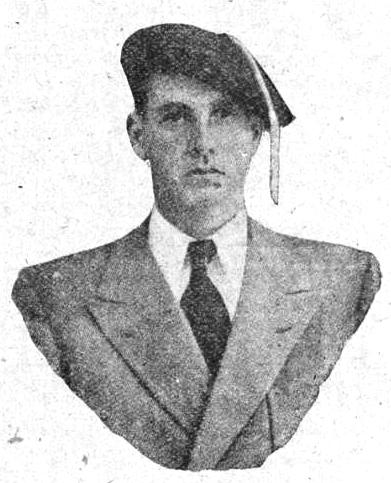 In 1945, del Burgo became a leader of the Comunión Católico-Monárquica, the carloctavista party. He was also the vice-president of Carlos VIII's Royal Council in Navarre. Don Carlos Pio was only three years older than del Burgo, and they became close friends, exchanging many letters. In the late 1940s, del Burgo worked to find new supporters. In 1950, he managed to restart the Navarrese AET as a carloctavista group.
In 1945, del Burgo became a leader of the Comunión Católico-Monárquica, the carloctavista party. He was also the vice-president of Carlos VIII's Royal Council in Navarre. Don Carlos Pio was only three years older than del Burgo, and they became close friends, exchanging many letters. In the late 1940s, del Burgo worked to find new supporters. In 1950, he managed to restart the Navarrese AET as a carloctavista group.
When Don Carlos Pio died unexpectedly in 1953, the carloctavistas were confused. Most of them supported Carlos VIII's older brother, Don Antonio. But del Burgo suggested supporting Carlos VIII's oldest daughter, Alejandra, as a temporary leader. This idea did not get much support. Del Burgo was left without clear royal loyalties. Over time, he became critical of Carlos VIII, feeling he had become too close to the Falange.
Working with the Government
Jaime del Burgo's support for the carloctavista group led him to change his view on Francoism. Don Carlos Pio had a strategy of working with Franco's government. In 1942, del Burgo ran in local elections for the Pamplona council and won. He served as a deputy mayor until 1944. In 1943, he was appointed a provincial delegate for communication and transport for the Falange. He also became vice-secretary of the Falange's Popular Education section. This showed he was willing to work with the Francoist government.
In 1949, when a new civil governor was appointed in Navarre, del Burgo became his trusted assistant. However, he turned down offers to become civil governor of other provinces, saying he would only accept a job in Navarre. In 1950, he became the provincial delegate for tourism and information. When Don Carlos Pio died, del Burgo felt lost because his strategy of working with the government ended.
In 1958, he was appointed to the Falangist Consejo Nacional del Movimiento, a national council. This position also made him a member of the Francoist parliament, the Cortes Españolas. He served in the committee that discussed basic laws. He was re-appointed in 1961 but not in 1964. Some sources say he resigned because he disagreed with Franco's government.
As a former radical youth activist and someone who had worked with the government, he might have seemed like a possible friend to the new generation of Carlist progressives. These new Carlists were also revolutionary and socially minded. However, there is no sign that del Burgo had any connection with them. One source suggests that as a delegate for the Ministry of Information and Tourism, he tried to stop their plans. He prevented Carlos Hugo, a new Carlist leader, from attending the annual Montejurra gathering in 1964.
A Dedicated Public Servant
In May 1936, Jaime del Burgo won a competition for a job at the Archivo de la Diputación Foral de Navarra, a regional archive. After the Civil War, in 1939, he continued his career as a public servant. The Navarrese government decided to make the existing Biblioteca de Navarra a separate public library, called the Biblioteca General de Navarra. Del Burgo became its first head and organizer. He led the library for 43 years. He oversaw its opening in 1941 and its move to a new building in 1972. He also changed it from a scholarly library to a public library for Navarre.
In addition to this, in 1941, del Burgo became the head of the Red de Bibliotecas de Navarra, which is the provincial network of local libraries. During his time, he opened 65 public libraries across the province. He was also active in professional groups for archivists and librarians until the late 20th century.
In 1950, del Burgo became the provincial delegate for the Ministry of Information and Tourism. In this role, he was in charge of the Francoist censorship office in Navarre. He banned many films, plays, books, and songs. He is especially remembered for censoring the advertisements for The Mark of Zorro movie. The original slogan, "Zorro, friend of the poor, feared by tyrants," was considered too dangerous for the government.
In 1964, del Burgo left the ministry and became the Director of Tourism, Libraries, and Popular Culture for the Navarrese government. He was responsible for mass culture. He edited and published about 400 popular brochures, writing some of them himself. He also organized hundreds of cultural events, mostly promoting traditional values. As head of tourism, del Burgo promoted Navarre across Spain. He also helped develop the Navarrese section of El Camino de Santiago, a famous pilgrimage route. He wrote tourist guides about Navarre. From the late 1960s, he was also the director of a school for applied arts. He retired from all his public jobs in 1982, just before his 70th birthday.
A Historian and Writer
As a historian, Jaime del Burgo focused mainly on Carlism and Navarre. He was especially interested in the 19th and 20th centuries and the history of foralism, which refers to special laws and rights. His works included large summaries, detailed studies, and biographies. He was an amateur historian, meaning he didn't have formal training. However, he did thorough research using original documents.
Del Burgo's most important historical work is the huge Bibliografía de las guerras carlistas (1953-1966). This work has five volumes and took him 25 years to complete. It lists more than 10,000 works and is still a key reference for anyone studying the Carlist wars. Another major work is Historia General de Navarra (1978), a large history of the region. He also wrote detailed studies on Carlism and Navarre, such as Carlos VII y su tiempo (1994) and La sucesión de Carlos II (1967). He also wrote Conspiración y guerra civil (1970), which is now often used as a historical source itself.
Historians praise del Burgo for his strong use of sources. However, critics often point out his Carlist bias. He has been criticized for trying to change the number of victims of the Rightist terror in Navarre. Other historians believe the numbers were four times higher. This disagreement is linked to the fact that del Burgo was personally accused of a war crime, which he always denied. He never held academic positions, but he became a corresponding member of the Real Academia de la Historia, a royal history academy. For his work on bibliographies, he received the National Literary Prize in 1967.
Literary Works
Jaime del Burgo started his writing career in the early 1930s. He published short plays about events from Carlist history. These plays, like Lealtad (1932) and Cruzados (1934), praised old Carlist values and had clear moral lessons. In 1937, he wrote a book of poetry called En Pos. Ensayo poético.
After the Civil War, del Burgo started writing novels. These included El valle perdido (1942), Huracán (1943), and Lo que buscamos (1951). The first two were set during the Civil War and praised patriotic actions. They had a traditional style but also included magical elements. The third novel had a different, more bitter tone. After focusing on historical research in the 1960s and 1970s, del Burgo returned to plays with Llamada sin respuesta (1978). He also wrote more poetry, Soliloquios: en busca de un rayo de luz perdido (1998), and a historical adventure novel, La Cruz del fuego (2000).
Even though he wrote a lot about Carlism, del Burgo is not widely known in the history of 20th-century Spanish literature. His novels are seen as having good historical information but are not highly praised for their artistic or literary quality. They are often described as repetitive and simple in their storytelling. Modern scholars point out two interesting things about his novels. One is a strong feeling for the Basque culture, showing an old, ideal Basque land. The other is a similar ideal view of rural life, which was a common Carlist idea that praised country living and mistrusted city life.
Del Burgo's novels were recognized with the Premio de Literatura y Periodismo de la Secretaria General de FET in 1954. Besides the national prize in 1967, he also received other awards. These included the Bayonne-Pamplona International Competition Award (1963), the Fundacion de Larramendi Award (1993), and the Badge of the Order of Alfonso X the Wise (1997). The last award was given by the Ministry of Education in 1999. He was a permanent councilor of the Institución Príncipe de Viana, a cultural institution. However, he never received the Viana Cultural Prize, which was started in 1990 by the Government of Navarre.
Images for kids
-
Villava, Escuela de Peritos Agrícolas
See also
 In Spanish: Jaime del Burgo para niños
In Spanish: Jaime del Burgo para niños
- Carlism
- Requeté
- Francoism
- Carloctavismo
- Carlo-francoism


